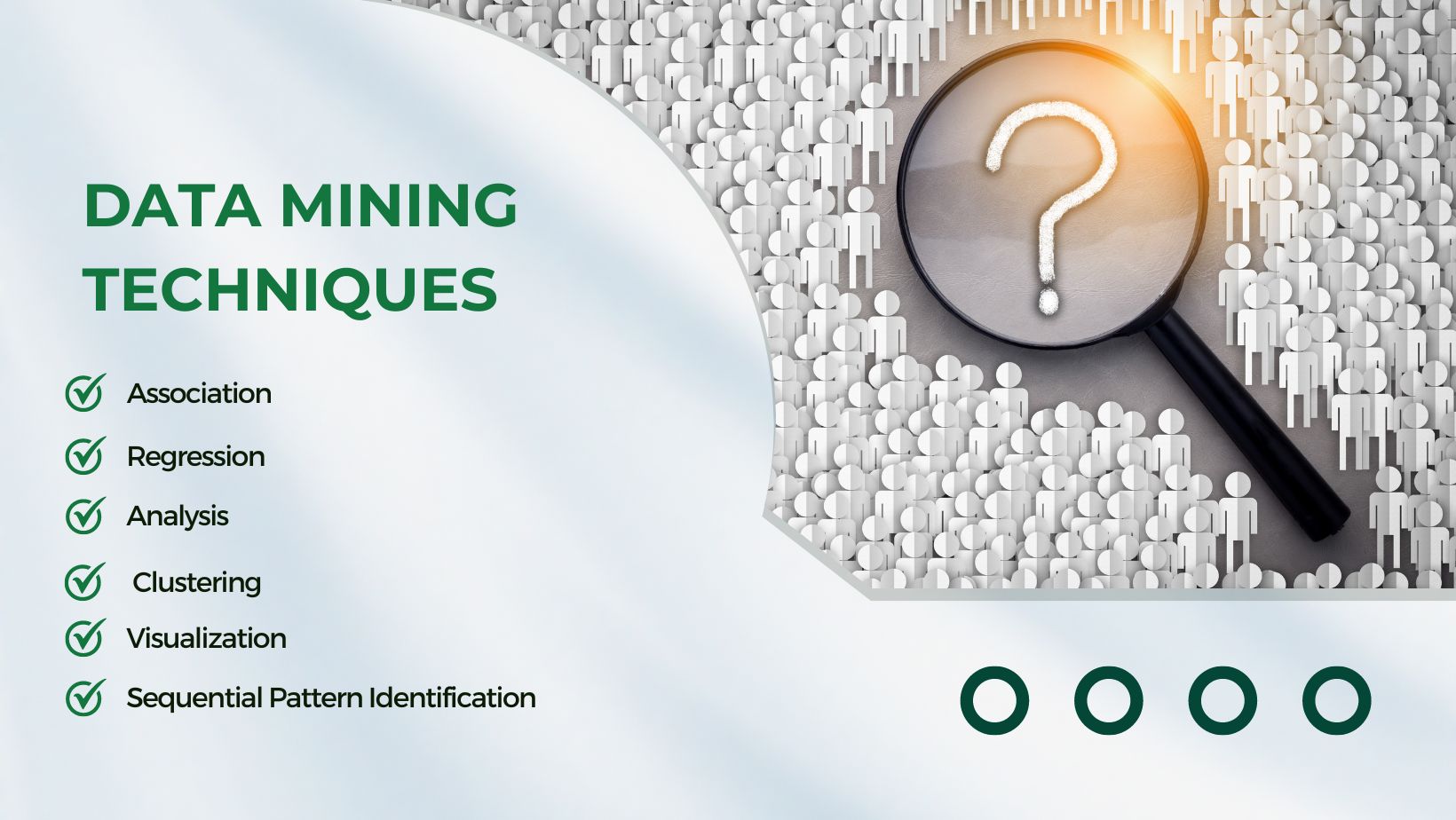Data mining extracts valuable knowledge from data that can lead to more informed decisions, improved processes, and innovative solutions across various sectors, ultimately driving growth, efficiency, and progress. It involves extracting valuable information from vast amounts of data to uncover hidden relationships and patterns that might not be immediately apparent.
What is Data Mining?
Data mining is the process of discovering valuable patterns, trends, correlations, or insights from large datasets using various techniques and algorithms. It involves extracting useful information from raw data to aid decision-making, growth predictions, and knowledge discovery.
For instance, an eCommerce business can use data mining to analyze customer purchases. By applying multiple techniques such as association rule mining and customer segmentation, they can identify which products are often bought together, group customers based on their preferences, and use predictive analytics to identify potential high-value customers. This helps them optimize marketing, store layout, or promotions, leading to increased sales and customer satisfaction.
Benefits of Data Mining
It plays a pivotal role in contributing to the growth and success of diverse industries and domains in several ways. Here are some of the key benefits of data mining.
Identifying Shopping Patterns
It allows businesses to analyze customer purchasing behavior, identifying which products are frequently bought together. This knowledge enables cross-selling opportunities, optimizing inventory placement, and increasing overall sales.
Determining Customer Groups
Data mining techniques like clustering help businesses group customers based on their preferences and buying habits. Understanding distinct segments allows for more customized and effective customer service strategies.
Measuring Profitability Factors
By analyzing the mined data, you can identify factors that impact profitability, such as pricing, product features, and marketing efforts. By understanding these factors, you can optimize your operations and maximize profits.
Increasing Brand Loyalty
Gain actionable insights into customer interactions and pain points to design targeted strategies, address customer concerns, and deliver personalized experiences. This, in turn, fosters brand loyalty and long-term customer relationships.
Predicting Future Trends
It leverages historical data to forecast future trends and demands. This predictive capability helps you stay ahead of the competition and prepare for upcoming market changes.
Facilitating Decision-Making
Since mining provides evidence-based insights, it aids you in making informed choices. Whether it’s launching new products, expanding into new markets, or optimizing business processes, data-driven decisions lead to better outcomes.
Detecting Fraud
In the financial sector, mining plays a crucial role in fraud detection. You can analyze transactional data and unusual patterns to prevent potential financial losses.
Prerequisites for Data Mining
Before you proceed to analyze the mined data using various techniques, it is essential to prepare the data. Here’s how you can do it:
Data Warehousing
Data warehousing is the process of collecting, storing, and organizing vast amounts of data from various sources into a centralized repository. This ensures that data is readily accessible for analysis and allows mining algorithms to work efficiently on comprehensive datasets.
Data Cleansing
Data cleansing, also known as data cleaning or scrubbing, identifies and rectifies errors, inconsistencies, and inaccuracies in the dataset. Once noisy and irrelevant data is eliminated, mining algorithms can produce more accurate and reliable results.
Data Mining Techniques

Several robust data mining techniques are used to extract valuable insights from large datasets. These play a crucial role in transforming raw data into actionable insights for businesses and researchers. Here are some of the most prevalent ones:
Association
This focuses on identifying relationships or associations between different data items in a dataset. It uncovers patterns such as “if A, then B,” which helps businesses understand which items are frequently bought together. For example, an online store might discover that customers who buy bread are likely to purchase jam as well.
Regression
Regression analysis is used in data mining to model the relationship between a dependent variable and one or more independent variables. It is beneficial for predicting continuous numerical values, such as sales revenue based on advertising expenditure or housing prices based on various features.
Analysis
This involves using statistical and mathematical techniques to analyze and interpret data patterns, trends, and relationships. It often incorporates analytics to gain deeper insights and make data-driven decisions.
Clustering
This technique groups data points based on their similarities. It helps in identifying natural clusters or segments within the data. This can be useful in customer segmentation, where customers with similar behaviors and preferences are grouped to pave the way for targeted marketing strategies.
Visualization
It represents complex datasets using charts, graphs, and other forms of visual representations to understand patterns and trends within the data. Visualization aids in presenting insights to stakeholders effectively and allows for more informed decisions.
Sequential Pattern Identification
It helps identify progressive relationships or patterns in data, such as frequent sequences of events or actions. This technique is commonly used in analyzing sequential data, such as web clickstreams, transaction logs, or follow-up patient treatment plans, to discover meaningful patterns and dependencies.
How Does Data Mining Work?
Throughout the data mining process, it is crucial to iterate and refine the steps to improve the quality and relevance of the results continuously. This process involves the following stages.
Business Understanding
The data mining process begins with clearly understanding the business problem and objective. It is essential to define the requirements of the mining project, ensuring that the analysis aligns with the organization’s strategic objectives.
Data Understanding
This stage involves gathering and exploring the available data to comprehensively understand its structure, quality, and relevance to the business problem. Further, the data’s characteristics, relationships between variables, and potential issues that may affect the analysis are examined.
Data Preparation
Data preparation is a critical step that involves cleaning, transforming, and preprocessing the data to make it suitable for analysis. This includes handling missing values, removing duplicates, and converting data into a format compatible with mining algorithms.
Mining
This pivotal phase involves the strategic application of mining techniques, such as analysis, clustering, association, and others, to uncover patterns, relationships, and insights within the prepared data.
Modeling
Predictive or descriptive models are developed based on the insights gained from the data mining phase. For instance, you could build a predictive model to forecast future purchase trends or a descriptive model to segment customers based on their purchasing habits.
Evaluation
Once you have created models, evaluate them to assess their accuracy and effectiveness in addressing the problem. Use rigorous validation techniques to test the model’s performance on unseen data and compare it against predefined criteria.
Deployment
Once a satisfactory model is identified and validated, deploy it into the operational environment. Integrate the insights derived from data mining into the business processes to enable stakeholders to make data-driven decisions and optimize operations.
Application of Data Mining Across Various Industries
It has diverse applications across various industries, revolutionizing decision-making processes and providing valuable insights. Here are some notable examples of how data mining is used in different sectors:
Retail and eCommerce
Recommendations: Data mining helps eCommerce businesses offer personalized product recommendations to customers based on their browsing and purchase history.
Market basket analysis: Retailers can use the mined data to identify product associations and optimize product placement for cross-selling opportunities.
Customer segmentation: Aids in segmenting customers based on buying behavior and preferences, enabling targeted marketing strategies.
Healthcare
Disease diagnosis: Data mining techniques analyze patient data to aid in early disease detection and diagnosis, improving treatment outcomes.
Drug discovery: Identify new candidate medications by analyzing biological data and predicting drug-target interactions.
Patient care: Healthcare providers can optimize patient care, track treatment outcomes, and manage patient populations effectively.
Finance
Fraud detection: Data mining helps detect fraudulent activities by analyzing transaction data and identifying suspicious patterns and anomalies.
Credit risk analysis: Financial institutions use data mining to assess creditworthiness and predict borrowers’ default probabilities.
Customer churn prediction: Mining enables identifying customers at risk of churning, allowing proactive retention strategies.
Manufacturing and Supply Chain
Predictive maintenance: Data mining helps in predicting equipment failures, enabling timely maintenance and reducing downtime in manufacturing processes.
Supply chain optimization: It aids in optimizing inventory management and supply chain operations, reducing costs, and enhancing efficiency.
Marketing and Advertising
Customer profiling: Mining helps the marketing and advertising teams create customer profiles to understand preferences and target campaigns.
Sentiment analysis: Certain mining techniques analyze social media and customer feedback to gauge sentiment and improve brand perception.
Ad campaign optimization: It helps in A/B testing and optimizing ad campaigns for higher conversion rates and better ROI.
Challenges and Limitations of Data Mining
While data mining offers powerful insights, it also comes with several challenges and limitations that organizations must address to ensure accurate analysis. Here are some key challenges:
Data Quality
It heavily relies on the quality of the input data. Inaccurate, incomplete, or inconsistent data can lead to erroneous results and biased conclusions. Ensuring data quality through data cleansing and validation is essential to obtain reliable insights.
Selection Bias
The models may have selection bias if the dataset used for analysis does not represent all the entities. Biased data can lead to skewed results, affecting decision-making and predictive accuracy.
Data Privacy Concerns
It often involves the use of sensitive and personal data. Extraction can raise privacy concerns, especially with the increasing emphasis on data protection regulations like GDPR and CCPA. Therefore, data must be responsibly handled and proper anonymization & security measures must be implemented.
Data Preprocessing Requirements
Data preprocessing, including data cleaning, transformation, and engineering, can be time-consuming and resource-intensive. Preparing data for analysis is crucial to ensure accurate and meaningful results.
Ethical and Legal Concerns
The practices can raise ethical and legal issues, especially when dealing with sensitive data or discriminatory practices. Establishing ethical guidelines and adhering to legal regulations while conducting data mining activities is critical.
Overfitting and Underfitting
Data mining models can be prone to overfitting, performing exceptionally well on the training data but failing to generalize to unseen data. On the other hand, underfitting occurs when the model is too simplistic and fails to capture the underlying patterns in the data.
Handling Large Datasets
Mining large datasets can be resource-intensive and require substantial processing power & storage capabilities. Efficient algorithms and scalable infrastructure are essential to handle big data challenges effectively.
How to Overcome the Limitations?
Since mining requires domain knowledge, consistent efforts, and considerable costs, you can overcome the limitations by implementing the following:
In-house Staff Training
Training your in-house teams in mining techniques and best practices can enhance data quality, improve data preprocessing, and enable better model interpretation.
Outsourcing Partners
Collaborating with third-party data mining companies can bring fresh perspectives and specialized knowledge, helping to address complex challenges and achieve more accurate results.
Automated Tools and Platforms
Leveraging automated data mining tools and platforms can streamline the data preprocessing, modeling, and evaluation processes, reducing manual efforts and human errors.
Now that we have ample knowledge about data mining, it is important to focus on its scope so that you can take the necessary steps and use it wisely for maximum business gains.
The Future of Data Mining
Well, it’s promising!
It will be pivotal in unlocking valuable insights and driving innovation across diverse domains as technology progresses. Here are some specific trends that are expected to shape the future of data mining:
The Rise of Big Data
As the amount of data being generated grows, businesses and organizations will need to find new ways to store, manage, and analyze this massive amount of data.
The Development of New Algorithms
As technology continues to grow, new algorithms will be developed that can better identify patterns and trends in data. These advancements will lead to improved applications of data mining across various industries, enabling more accurate and insightful analyses.
The Increasing Use of Artificial Intelligence
AI-powered mining tools are becoming more sophisticated, making it easier for businesses to harness the power of data mining to enhance their decision-making and operations.
IoT (Internet of Things)
As IoT devices generate vast amounts of data, data mining will be applied to extract meaningful insights. This will enable businesses to optimize IoT device performance, predict failures, and improve operational efficiency.
Unstructured Data Mining
Data mining expands beyond structured datasets to include unstructured data such as text, images, audio, and video. Natural Language Processing (NLP) and computer vision techniques will be integrated with data mining to extract valuable information from unstructured sources.
It’s Your Turn to Leverage Data Mining for Escalated Business Growth
Seize the opportunity to leverage data mining and unleash its transformative capabilities to propel your business to new heights of success and innovation. Embrace the data-driven future and position your organization at the forefront of a data-powered revolution. The path to escalated business growth lies in your hands – let data mining be your guide to success.






